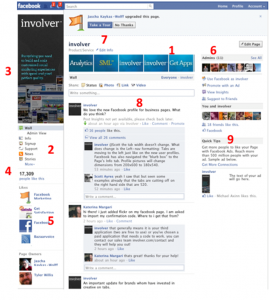Changes to Facebook Pages
 by Rosalyn Eishen | @rosalynchoo
Recently Facebook announced major changes to the design and functionality of its Pages, which are similar to individual user profiles in look and functionality. These updates will improve our customers’ ability to connect with audiences. The changes impact the user experience visually and functionally, allowing brands and companies to operate more the way individual users do.
by Rosalyn Eishen | @rosalynchoo
Recently Facebook announced major changes to the design and functionality of its Pages, which are similar to individual user profiles in look and functionality. These updates will improve our customers’ ability to connect with audiences. The changes impact the user experience visually and functionally, allowing brands and companies to operate more the way individual users do.
One of the things you’ll notice is that Facebook Pages have been made to look like Facebook Profiles. The changes also greatly increase one’s ability to create richer application experiences using iFrames. In addition, brands will also have greater flexibility in the way they name them.
The mentioned changes will take effect for all Facebook Pages on March 10 (with a mandatory switch), which gives you 4 weeks to preview the new format and switch over when you are ready and comfortable with the new look. The changes will certainly enhance all functionality, so it’s important to learn how they work in order to make the most of this new look and feel.
Below is a map of the changes, followed by an additional summary:
1-Photo strip above the Wall (with most recent photos you posted or tagged) 2-Tabs move over to the left panel, in the form of a list (maximum of 6 above the fold) 3-Profile picture reduced from 200 x 600 pixels to 180 x 540 4-Blurb box that was below the Page picture moved to info tab 5-Pages can Like other Pages, not just favorite them 6-Featured Pages and Admins 7-Page category 8-Choice for Wall posts between “Everyone” and Page posts only 9-Mutual Friends and Interests section 10-Ability to interact on Facebook as your Page 11-Ability for admins to post and comment around the site under their Page’s alias 12-News feed of updates from Liked Pages 13-Pages can now feature iFrame tab applications 14-Email notifications when users post or comments
• Photo Strip Instead of Tabs Above the Wall The replacement of tabs with the photo strip at the top adds a dynamic, colorful element that will significantly improve the look of the average Facebook Page. The photos are drawn from the most recent ones you posted to your Wall and those you tagged, but does not include photos posted by fans. Users can hide undesirable photos. The new left nav placement of tabs also allows for longer tab names.
• Expanded Functionality For Fan Page Admins By enabling Fan Page admins to comment in the name of the page itself and to interact with other Fan pages, Facebook has finally made it possible for brands to truly engage in tremendous interactive engine which powered its growth among individuals. Your power as a page administrator is increased in a number of other ways, including the ability to set filters on your Wall so that visitors see relevant posts first, and to view all the content and get notices whenever someone posts to your wall.
• “Like” Pages can now “like” other pages. Then status updates from the pages you liked would then appear in your News Feed (yes, Pages now have a News Feed as well).
• Wall Filters Facebook is providing two Wall filters: Showing posts by your page and top posts from everyone. This gives people a way to see the most “interesting” stories first. Unfortunately, this doesn’t mean they see the stories that are most important or relevant to the messages you hope to communicate to the public. If you’re the only one posting updates, this becomes moot. But imagine what will happen to the view for Pages where the fans post frequently.
• Settings With the new page features, you can now receive email notifications when someone posts something on your wall. This will be very helpful in helping you monitor your page activity. It is also possible for you to change your email notifications for each page. Also, in settings you can chose whether you post a comment as yourself, or as your page.
• Policies You should review the new policies. While many applications like Flash will now function better on your Page, Facebook’s restrictions require you to limit their functionality until a user interacts with it.
Sources: Mashable http://mashable.com/2011/02/11/new-facebook-pages-brands/ TechCrunch http://techcrunch.com/2011/02/10/facebook-unifies-ui-as-it-rolls-out-new-design-for-pages/

